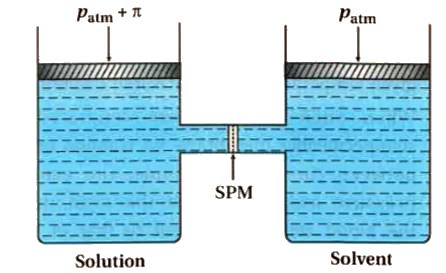What is osmotic pressure ? Explain and derive equation. Solution in Gujrati
The flow of the solvent from its side to solution side across a semipermeable membrane can be stopped if some extra pressure is applied on the solution. This pressure that just stops the flow of solvent is called osmotic pressure (π) of the solution. In short, the pressure which stops the spontaneous flow of solvent is known as osmotic pressure (π) of the solution.
The flow of solvent from dilute solution to the concentrated solution across a semipermeable membrane is due to osmosis. The important point to be kept in mind is that solvent molecules always flow from lower concentration to higher concentration of solution. The osmotic pressure has been found to depend on the concentration of the solution.

Osmotic pressure is a colligative property as it depends on the number of solute molecules and not on their identity. For dilute solutions, osmotic pressure is proportional to the molarity, C of the solution at a given temperature T. Thus ,
∴π= CRT ∴π=n2VRT
Here, π is the osmotic pressure, R is the gas constant and V is the volume of solution.
V is volume of a solution in litres containing n2 moles of solute. If w2 grams of solute, of molar mass, M2 is present in the solution, then n2=w2M2
∴πV=w2RTM2
Thus, knowing the quantities w2,Tπ and V we can calculate the molar mass of the solute.
Topper's Solved these Questions
- BOOK - KUMAR PRAKASHANCHAPTER - SOLUTIONS EXERCISE - SECTION - A QUESTIONS (SELF - PRACTICE QUESTIONS)37videos
SOLUTIONS
- BOOK - KUMAR PRAKASHANCHAPTER - SOLUTIONS EXERCISE - SECTION - A QUESTIONS (TRY YOURSELF)29videos
SOLUTIONS
- BOOK - KUMAR PRAKASHANCHAPTER - SOLUTIONS EXERCISE - SECTION - E MCQs asked in GUJCET/Board Exam69videos
SOLUTIONS
- BOOK - KUMAR PRAKASHANCHAPTER - SAMPLE QUESTION PAPER EXERCISE - [PART-B] SECTION - C2videos
SAMPLE QUESTION PAPER
- BOOK - KUMAR PRAKASHANCHAPTER - SURFACE CHEMISTRYEXERCISE - SECTION - E (MCQs asked in GUJCET/Board Exams)52videos
SURFACE CHEMISTRY
Similar Questions
Given examples of gaseous solute and solvent.
05:11View SolutionIf 5.85 gm of NaCl is dissolved in 90 gm of water, then find out the mole fraction of NaCl.
06:52View SolutionFreezing point of urea solution is −0.60C. How much urea is required to be dissolved in 3 kg water ? [M(urea)=60gmol−1,Kf=1.50C Kg mol−1]
02:22View Solution0.6 ml acetic and having the density 1.06 g mL−1 is dissolved in 1 litre water. It's shows the depression in freezing point of 0.020.5∘C. Calculate want haff factor and Ka of an acid.
02:28View SolutionName the catalyst [X] for the reaction,
CO(g)+H2(g)[X]−−→HCHO(g)04:06View Solutionजल विभव क्या है ? परासरण विभव , मेट्रिक्स विभव तथा दाब विभव को स्पष्ट कीजिए ।
05:14View Solutionपरासरण दाब के विभिन्न नियमो का वर्णन कीजिए तथा वांट हॉफ समीकरण की व्युत्पत्ति कीजिए यह दर्शाइए कि परासरण दाब एक अणुसंख्य गुणधर्म है ।
04:06View Solutionपरासरण दाब को उदाहरण द्वारा समझाइए ।
05:48View Solutionतनु विलयन के परासरण दाब और सांद्रण में क्या संबंध है? स्पष्ट कीजिये।
04:12View Solutionपरासरण दाब किसे कहते है व्याख्या कीजिये
03:23View Solutionपरासरण दाब किसे कहते है ? इसकी सहायता से अवाष्पशील विलेय का अणुभार ज्ञात करने का एक समीकरण की व्युत्पत्ति कीजिए |
03:23View Solutionपरासरण दाब किसे कहते है ? इसकी सहायता से अवाष्पशील विलेय का अणुभार ज्ञात करने का एक समीकरण की व्युत्पत्ति कीजिए |
02:04View SolutionExplain the terms osmosis and osmotic pressure.
03:20View SolutionExplain the terms osmosis and osmotic pressure.
02:38View SolutionWhat is Van't Hoff equation for osmotic pressure ?
04:08View Solution

